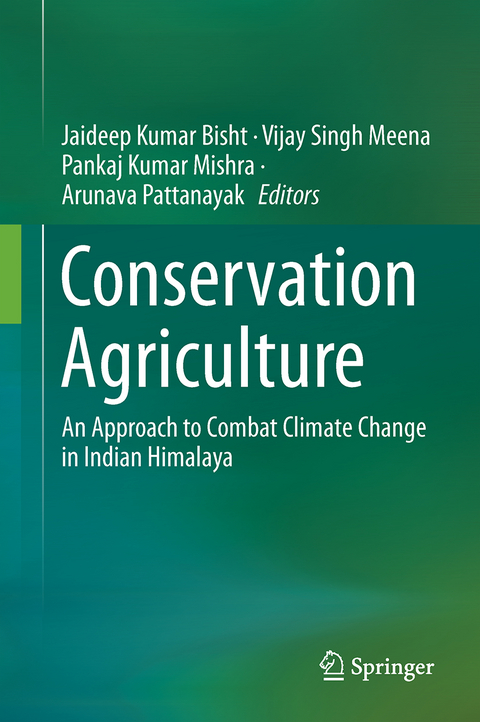
Conservation Agriculture
Springer Verlag, Singapore
978-981-10-2557-0 (ISBN)
Dr. Jaideep Kumar Bisht is currently working as Principal Scientist & Head of Crop Production Division in ICAR-Vivekananda Institute of Hill Agriculture, Almora, Uttarakhand, India Dr. Vijay Singh Meena is currently working as Scientist in ICAR-Vivekananda Institute of Hill Agriculture, Almora, Uttarakhand, India Dr. Pankaj Kumar Mishra is currently working as Principal Scientist in ICAR-Vivekananda Institute of Hill Agriculture, Almora, Uttarakhand, India Dr. Arunava Pattanayak is currently working as Director in ICAR-Vivekananda Institute of Hill Agriculture, Almora, Uttarakhand, India Meena VS, Meena SK, Verma JP, Meena RS, Ghosh BN, 2015. The needs of nutrient use efficiency for sustainable agriculture. Journal of Cleaner Production. 102, 562–563. Meena VS, Maurya BR, Verma JP, Aeron A, Kumar A, Kim K, Bajpai VK, 2015. Potassium solubilizing rhizobacteria (KSR): Isolation, identification, and K-release dynamics from waste mica. Ecological Engineering. 81, 340–347. Bisht, J.K., Saha, S. and Srivastava, A.K. (2009). Agronomic performance and fodder of dualpurpose barley cultivars under rainfed condition of N-W. Forage Res., 35 (1): pp. 12-16.Tuti, M.D., Pal, R.S., Kumar, R., Bisht, J.K. and Bhatt, J.C. (2015). Colocasia-based cropping systems affects the antioxidants properties and productivity of colocasia (Colocasia esculanta (L.) Schott) tuber. The Bioscan . 10(1):117-123. Yadav, R.P. and Bisht, J.K. (2014). Litter fall and potential returns from Pecan nut (Carya illinoinensis) in agroforestry system in Indian Himalaya. International Journal of Herbal Medicine. (2)1.51-52. Mishra, P.K., Bisht, S.C., Mishra, Jeevanandan, K., Kumar, S., Bisht, J.K. and Bhatt, J.C (2014). Synergistic effect of inoculating plant growth- promoting Pseudomonas spp. AndRhizobium leguminosarum-FB1 and nutrient uptake of rajmash (Phaseolus vulgaris L.).Archives of Agronomy and Soil science, 60(6):799-815 Selvakumar, Govindan, Joshi, Piyush, Suyal, Preeti, Gopal. Joshi, K., Mishra Pankaj K.,Venugopalan, R. Bisht, Jaideep K., Bhatt, Jagdish. C. and Gupta, Hari S. (2013) Rock phosphate solubilization by psychrotolerant Pseudomonads and their effect on lentil (Lens culinaris) growth and nutrient uptake under poly house condition. Annals Microbiology, 63(4): 1353-1362.
Chapter1: Conservation agriculture and climate change: An overview.- Chapter 2: Conservation agriculture: A new paradigm for improving input use efficiency and crop productivity.- Chapter 3: Resource Conservation technologies (RCTs) for climate resilient agriculture in foothill of North West Himalayas.- Chapter 4: Role of biofertilizers in conservation agriculture.- Chapter 5: Sustainable agrochemicals for conservation of agriculture and climate change.- Chapter 6: Role of genetic resources of forages in the present changing climatic scenario.- Chapter 7: Towards the climate change and community based adaptation-mitigation strategies in hill agriculture.- Chapter8: Agroforestry for natural resource conservation, livelihood security and climate change mitigation in Himalayan Agro-ecosystems.- Chapter 9.- Elevated carbon dioxide (CO2) and temperature vis- a-vis carbon sequestration potential of global terrestrial ecosystem.- Chapter 10: Climate change risk perception, adaptation, and mitigation strategy: an extension outlook in Mountain Himalaya.- Chapter 11: Towards the C sequestration potential of agroforestry practices to combat climate change in Kumaon Himalaya, India.- Chapter 12: Soils conservation of North-West Himalayas (NWH): Their constraints and potentials for sustainable hill agriculture.- Chapter 13: Towards the sustainable management of problematic soils in north eastern India.- Chapter 14: The Indian Himalayan ecosystem as sources for survival.- Chapter 15: Soil degradation in North- West Himalayas (NWH): a case study of Himachal Pradesh.- Chapter 16: Towards the natural resource management for resilient shifting cultivation system in eastern Himalayas.- Chapter 17: Impact, adaptation and vulnerability of Indian agriculture towards the climate change.- Chapter 18: Potential impacts of climate change on quality seed production: a perspective of Hill agriculture.- Chapter 19: Impact of climate change on water resources in Indian Himalaya.- chapter 20: Diversity among rice landraces under static (ex-situ) and dynamic (on-farm) management a case from north-western Indian Himalayas.- Chapter 21: Effect of climate change on growth and physiology of rice-wheat genotypes.- Chapter 22: Dose a rice breeding enhance the drought tolerance under the changing climate scenario.
| Erscheinungsdatum | 14.12.2016 |
|---|---|
| Zusatzinfo | 68 Illustrations, color; 15 Illustrations, black and white; XV, 559 p. 83 illus., 68 illus. in color. |
| Verlagsort | Singapore |
| Sprache | englisch |
| Maße | 155 x 235 mm |
| Themenwelt | Naturwissenschaften ► Biologie ► Ökologie / Naturschutz |
| Naturwissenschaften ► Geowissenschaften ► Geologie | |
| Weitere Fachgebiete ► Land- / Forstwirtschaft / Fischerei | |
| Schlagworte | Agricultural sustainability • climate change • Conservation Agriculture • C-sequestration • Soil–plant–microbes–environmental sustainability |
| ISBN-10 | 981-10-2557-6 / 9811025576 |
| ISBN-13 | 978-981-10-2557-0 / 9789811025570 |
| Zustand | Neuware |
| Haben Sie eine Frage zum Produkt? |
aus dem Bereich


